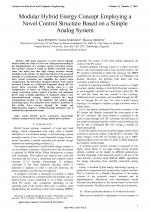| 2/2016 - 1 | View TOC | « Previous Article | Next Article » |
Modular Hybrid Energy Concept Employing a Novel Control Structure Based on a Simple Analog SystemPETREUS, D. |
| Extra paper information in |
| Click to see author's profile in |
| Download PDF |
Author keywords
DC-DC power converters, photovoltaic systems, analog circuits, wind energy, hybrid power systems
References keywords
power(24), energy(11), system(7), wind(6), maximum(6), grid(6), point(5), photovoltaic(5), control(5), tracking(4)
Blue keywords are present in both the references section and the paper title.
About this article
Date of Publication: 2016-05-31
Volume 16, Issue 2, Year 2016, On page(s): 3 - 10
ISSN: 1582-7445, e-ISSN: 1844-7600
Digital Object Identifier: 10.4316/AECE.2016.02001
Web of Science Accession Number: 000376996100001
SCOPUS ID: 84974829731
Abstract
This paper proposes a novel control topology which enables the setup of a low cost analog system leading to the implementation of a modular energy conversion system. The modular concept is based on hybrid renewable energy (solar and wind) and uses high voltage inverters already available on the market. An important feature of the proposed topology is a permanently active current loop, which assures short circuit protection and simplifies the control loops compensation. The innovative analogue solution of the control structure is based on a dedicated integrated circuit (IC) for power factor correction (PFC) circuits, used in a new configuration, to assure an efficient inverter start-up. The energy conversion system (control structure and maximum power point tracking algorithm) is simulated using a new macromodel-based concept, which reduces the usual computational burden of the simulator and achieves high processing speed. The proposed novel system is presented in this article from concept, through the design and implementation stages, is verified through simulation and is validated by experimental results. |
| References | | | Cited By |
Web of Science® Times Cited: 5 [View]
View record in Web of Science® [View]
View Related Records® [View]
Updated 3 weeks, 6 days ago
SCOPUS® Times Cited: 5
View record in SCOPUS® [Free preview]
View citations in SCOPUS® [Free preview]
[1] Design and Simulation of Romanian Solar Energy Charging Station for Electric Vehicles, Badea, Gheorghe, Felseghi, Raluca-Andreea, Varlam, Mihai, Filote, Constantin, Culcer, Mihai, Iliescu, Mariana, Răboacă, Maria Simona, Energies, ISSN 1996-1073, Issue 1, Volume 12, 2018.
Digital Object Identifier: 10.3390/en12010074 [CrossRef]
[2] Digital Electronic System-on-Chip Design: Methodologies, Tools, Evolution, and Trends, Cirstea, Marcian, Benkrid, Khaled, Dinu, Andrei, Ghiriti, Romeo, Petreus, Dorin, Micromachines, ISSN 2072-666X, Issue 2, Volume 15, 2024.
Digital Object Identifier: 10.3390/mi15020247 [CrossRef]
[3] FPGA-Based Controller for a Hybrid Grid-Connected PV/Wind/Battery Power System with AC Load, Allani, Mohamed Yassine, Riahi, Jamel, Vergura, Silvano, Mami, Abdelkader, Energies, ISSN 1996-1073, Issue 8, Volume 14, 2021.
Digital Object Identifier: 10.3390/en14082108 [CrossRef]
[4] A Power Electronic Traction Transformer Model for a New Medium Voltage DC Electric Railway, FERENCZ, I., PETREUS, D., Advances in Electrical and Computer Engineering, ISSN 1582-7445, Issue 3, Volume 21, 2021.
Digital Object Identifier: 10.4316/AECE.2021.03012 [CrossRef] [Full text]
Disclaimer: All information displayed above was retrieved by using remote connections to respective databases. For the best user experience, we update all data by using background processes, and use caches in order to reduce the load on the servers we retrieve the information from. As we have no control on the availability of the database servers and sometimes the Internet connectivity may be affected, we do not guarantee the information is correct or complete. For the most accurate data, please always consult the database sites directly. Some external links require authentication or an institutional subscription.
Web of Science® is a registered trademark of Clarivate Analytics, Scopus® is a registered trademark of Elsevier B.V., other product names, company names, brand names, trademarks and logos are the property of their respective owners.
Faculty of Electrical Engineering and Computer Science
Stefan cel Mare University of Suceava, Romania
All rights reserved: Advances in Electrical and Computer Engineering is a registered trademark of the Stefan cel Mare University of Suceava. No part of this publication may be reproduced, stored in a retrieval system, photocopied, recorded or archived, without the written permission from the Editor. When authors submit their papers for publication, they agree that the copyright for their article be transferred to the Faculty of Electrical Engineering and Computer Science, Stefan cel Mare University of Suceava, Romania, if and only if the articles are accepted for publication. The copyright covers the exclusive rights to reproduce and distribute the article, including reprints and translations.
Permission for other use: The copyright owner's consent does not extend to copying for general distribution, for promotion, for creating new works, or for resale. Specific written permission must be obtained from the Editor for such copying. Direct linking to files hosted on this website is strictly prohibited.
Disclaimer: Whilst every effort is made by the publishers and editorial board to see that no inaccurate or misleading data, opinions or statements appear in this journal, they wish to make it clear that all information and opinions formulated in the articles, as well as linguistic accuracy, are the sole responsibility of the author.



